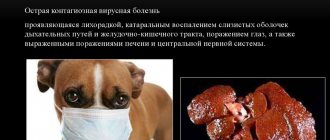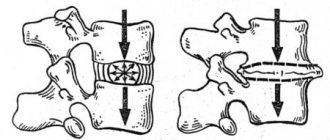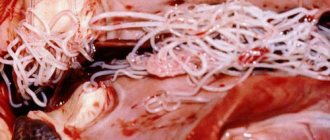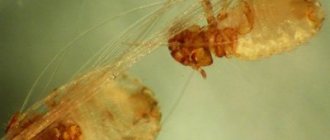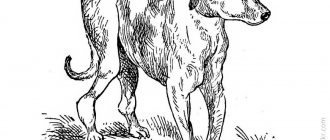Why are fleas dangerous?
The most common problem associated with flea bites is flea allergic dermatitis (FAD), manifested by itching, excessive shedding, hair loss and even baldness. Dogs suffering from itching become less obedient and irritated.
A common complication of flea allergy dermatitis is pyoderma, a bacterial skin infection in which the skin may become red, moist, sticky, crusty, and pustular.
Treatment of a bacterial infection can be lengthy, and bacteria may develop resistance to antibiotics. Small dogs may develop anemia (anemia) due to constant blood loss associated with feeding on a large number of fleas. There is evidence that up to 700 fleas were found on one dog! In addition, fleas are carriers of the helminth – cucumber tapeworm (Dipylidium caninum), which develops in the small intestine of animals (including dogs and cats) and humans. Infection occurs through accidental ingestion of infected fleas and their larvae. Small children who play on the floor in a room with a flea-infested dog are often infected.
Breeds prone to mange
Any animal can get sick, but most likely this will happen to those tails that have reduced immunity.
But there is also a breed predisposition, for example, for demodicosis:
- boxers;
- pugs;
- French Bulldog;
- Rottweiler;
- German Shepherd;
- Staffordshire Terrier;
- dachshunds;
- Dobermans;
- English and American cocker spaniel (the greatest tendency to damage the limbs is demodicosis of the paws).
Breeds with long, floppy ears are most susceptible to otodectosis.
Causes of sarcoptic mange in dogs
The development of sarcoptic mange in dogs is caused by mites of the genus Sarcoptes - small (0.2 - 0.5 mm) parasites that penetrate the epidermis (upper layer of skin) of the animal.
Gnawing passages in it and actively reproducing, they feed on lymph, epidermal cells and tissue decay products that are formed as a result of their vital activity. During its life (about 1 month), one female tick lays up to 60 eggs, from which new parasites appear, which leads to the progression of the disease.
Ways of infection of dogs with sarcoptic mange
Itching mites are permanent inhabitants of nature. They can be found in soil, water, on plant leaves, etc. In the external environment they are inactive, do not reproduce and die quite quickly. Therefore, cases of dogs being infected with sarcoptic mange during a walk are rare and the main route of transmission of the disease is direct contact with a sick animal or the use of its care and maintenance items (comb, collar, bed, etc.).
However, we should not forget that the mites that cause sarcoptic mange in dogs are parasites and for their reproduction they need a host, in whose epidermis they lead active life activities. Constantly searching for their specific owner, they move around and can land on various objects, such as the dog owner's shoes or clothes, which can also lead to infection of the pet.
Another problem associated with the transmission of sarcoptic mange is asymptomatic carriers of the disease. Migrating in search of their specific host, itch mites can temporarily settle on the skin of cats, rabbits, pigs, horses and other animals, upon contact with which the dog can get sick. Dogs that regularly undergo antiparasitic treatment can also be asymptomatic carriers of the disease.
Symptoms of sarcoptic mange in a dog
Like any other disease, sarcoptic mange has its own incubation period - the time required for the tick to penetrate the epidermis, begin reproduction and receive a response from the animal’s body to its vital activity. Depending on the age and state of the dog’s immunity, this may take from 2 to 7 days or more. At the same time, in puppies and pets who have previously had sarcoptic mange, symptoms of the disease appear earlier than in adult dogs with high (strong) immunity. Next, we will take a closer look at the symptoms of sarcoptic mange in dogs as they increase.
- Redness of areas of skin with shorter hair: on the face, ears, neck, abdomen, armpits, elbow and knee joints, etc.
- Otopedal (ear-foot) reflex: quite often, especially while stroking the owner, the pet begins to scratch itself with its hind paw.
- Small papules (nodules) filled with clear liquid appear on reddened areas of the skin.
- An increase in itching and anxiety, which leads to scratching the papules, in place of which crusts form.
- Increasing itching: the dog scratches its skin until it bleeds, causing scabs to form on its surface.
- Development of alopecia (baldness): hairless areas with roughened skin, subject to increased keratinization and cracking, are formed.
Looking at sarcoptic mange in dogs at different stages of the disease, one can notice a progressive deterioration in the appearance of the animal. At the same time, it suffers from severe itching, changes its habits, and refuses to eat. It emits a characteristic sour odor, and due to constant trauma to the skin during scratching and the formation of wounds, a secondary infection is observed. Without timely treatment of sarcoptic mange, the dog develops paresis (neurological syndrome) of the limbs, it rapidly weakens and loses weight. The disease becomes chronic, generalized (spreads over the entire surface of the skin) form, depleting the pet’s strength, and ultimately it dies.
Otodectosis
Although the causative agent of otodectosis is larger than some of its relatives, it is still impossible to see it with the naked eye; its size is only up to 0.5 millimeters. They live inside the ear and feed on wax and epithelium.
This disease is widespread among dogs. If no measures are taken, then mites cause inflammation of the ear canal - otitis media, and this already has very serious complications.
Main clinical symptoms
- Severe itching, the dog constantly scratches its ears, sometimes tearing them into blood;
- shakes his head (actually due to itching);
- plaque forms in the ears. These clusters are dark brown or black in color and can be either dry or wet.
Treatment
It’s not at all difficult to get rid of ear mites if you don’t start the disease.
It is important not to stop halfway, for example, different drops need to be instilled again, after a certain number of days (this depends on the specific drug), it is not enough to drop once and that’s it.
The prescription of drugs depends on the stage of the disease, but there is a general algorithm of action:
- Clean the ears with a cotton pad or gauze soaked in chlorhexidine or a special lotion.
- Before visiting the veterinarian, do not clean your dog’s ears under any circumstances, this will complicate the diagnosis!
- A drug is injected into the cleaned ear, usually drops. Most often, Aurikan, Bars, and Tsipam are prescribed for otodectosis.
- After administration, the ear should be massaged for better distribution of the medicine.
Don't self-medicate! If the animal’s condition worsens, contact a specialist.
Diagnosis of sarcoptic mange in dogs
In order to differentiate sarcoptic mange from diseases with similar symptoms (dermatitis, folliculitis, pyoderma, etc.) and make an accurate diagnosis, microscopy is performed: a superficial scraping of the animal’s epidermis is performed and the resulting sample is examined under a microscope to detect mites or mites deposited by them eggs
When correctly diagnosing sarcoptic mange in dogs using microscopy, the accuracy of the diagnosis is high, but not 100%. To do this, scrapings of the epidermis must be performed from as large a surface of the skin as possible, especially in problem areas where redness, scratching, papules and other signs of disease are observed. But sometimes it is not possible to detect mites in scrapings.
If microscopy is carried out incorrectly, parasitic mites and their eggs are found only in half of the cases of the disease, which significantly complicates making an accurate diagnosis. If the dog exhibits characteristic symptoms of sarcoptic mange, a trial treatment is prescribed.
Animal treatment
If several dogs live in the house, the sick dog should be isolated at the first signs of illness.
Treatment begins with the dog being often bathed with tar soap and antiseborrheic shampoo to wash away dandruff, dirt, and germs. Before this, the hair in the affected areas is cut short. After shampoo, the animal is rinsed with a decoction of celandine, chamomile, and string.
Treatment begins with thorough washing with shampoo.
Tar, sulfur, and tetracycline ointments are applied to the scratches twice a day. Among medicines, the drug “Benzyl benzoate” has found wide use. It has no effect on eggs, but causes the death of adults and larvae in 10-30 minutes. A 20% emulsion is prepared based on Benzyl benzoate, water and green soap. The product can be prepared for a week and stored in the refrigerator. In addition to this substance, there are a number of drugs used to treat sarcoptic mange, but they must be prescribed by a veterinarian. This is primarily due to the fact that acaricidal substances are very toxic. In addition to medications that kill ticks, the doctor must prescribe antibiotics, sedatives and antiallergic medications.
How is sarcoptic mange treated in dogs?
It is important to know! Sarcoptic mange is not a harmless scabies. This is a serious, rapidly progressing disease of a parasitic nature. After all, mites that have penetrated the skin of a pet continuously multiply, make new passages in the epidermis and spread throughout the skin. It is impossible to get rid of them using folk remedies. Therefore, self-medication with the use of various kinds of herbs, lotions, and other drugs is strictly prohibited!
Competent treatment of sarcoptic mange in dogs involves the use of modern antiparasitic drugs. One of these drugs is Stronghold in the form of drops that are applied to the animal’s withers. Selamectin, which is part of them, demonstrates a pronounced antiparasitic effect against sarcoptic mites and works as follows.
- The drug blocks the transmission of neuromuscular impulses in parasites, which leads to paralysis and death of adult ticks.
Thanks to this action, Stronghold destroys itch mites quickly enough. And for the animal to fully recover, only 2 treatments are required with an interval of 30 days. The use of the drug helps to shorten the treatment time for sarcoptic mange in dogs and does not cause harm to their body (in recommended doses). Stronghold drops on the withers can be applied to adult dogs, pregnant/lactating bitches and puppies, starting from 6 weeks of age. The convenient form of release in the form of a pipette with drops greatly simplifies this process: its contents simply need to be applied to the skin in the area of the pet’s withers, having first parted the hair growing on it so that the antiparasitic drops fall directly on the dog’s skin and are evenly distributed over its surface. Over the next two hours, the pet should not be bathed or stroked over the treated area (at the withers). The therapeutic effect achieved in this case lasts for 1 month, after which it is recommended to repeat the treatment.
As for the recommended doses of the drug, in this case it is difficult to make a mistake. Stronghold is available in the form of drops for dogs of different ages and weights.
- For puppies weighing less than 2.5 kg, the pipette contains 15 mg of active ingredient.
- For puppies and adult dogs weighing from 2.6 to 5 kg - 30 mg of active ingredient.
- Adult pets weighing from 5 to 10 kg – 60 mg of the drug.
- For dogs weighing from 10 to 20 kg - 120 mg selamectin.
- Animals whose weight is from 20 to 40 kg - 240 mg.
- For dogs weighing more than 40 kg, a combination of pipettes is selected that is suitable for their weight.
It is also important to note that the drug Stronghold is used not only for the treatment of sarcoptic mange in dogs, but also for the treatment and prevention of infection by other parasites, such as fleas, lice, lice, ear mites, roundworms and heartworms.
To reduce itching and care for the affected skin of a pet with sarcoptic mange, it is recommended to use special bathing products. In this case, all animals living in the house without exception are subject to antiparasitic treatment: other dogs, cats, etc. After all, any of the pets may be an asymptomatic carrier of the disease, which will not hesitate to reappear.
It is important to know! The appropriateness, dose and regimen of taking any antiparasitic drugs for the treatment of diseases is determined by a veterinarian. You should not independently select medications for the treatment of sarcoptic mange in dogs, as they may have a number of contraindications and restrictions! Before using Stronghold as a remedy, it will also not hurt to consult a veterinarian.
Forecast
Sarcoptic mange is debilitating for a dog and does not go away spontaneously, but is highly treatable. The prognosis is favorable.
It will take 4 to 8 weeks to completely eliminate itching and restore skin and fur. However, noticeable improvement occurs within the first 14 days. The rate of recovery depends on the size of the lesion, the severity of the lesion, and the animal’s immunity.
If after 6 weeks from the start of treatment there are no noticeable improvements, the itching does not go away, additional studies are prescribed to determine the real cause of the disease.
Infection with scabies can be avoided if you keep your pet away from dogs with obvious signs of sarcoptic mange and use anti-mite means: drops on the withers, collars or tablets.
Why is sarcoptic mange dangerous in dogs?
Sarcoptic mange in dogs, the symptoms and treatment of which we have already examined in detail, cannot go away on its own. The pet's appearance and general condition will deteriorate every day, not to mention the suffering the animal experiences as the disease progresses. Without treatment, it takes on a chronic form, the course of which is accompanied by a host of potentially dangerous problems: wound infection, general intoxication of the body, enlarged lymph nodes, paresis, etc.
In addition, sarcoptic mange is dangerous not only for dogs, but also for their owners. The problem is that mites of the genus Sarcoptes can cause a person to develop pseudosarcoptosis - a dermatological disease characterized by severe itching and the formation of inflammatory elements (rashes) on the skin: blisters, papules, etc. The disease develops rapidly and causes suffering. Considering the fact that ticks do not penetrate the human epidermis, but only bite him, the disease eventually goes away. But in children and people prone to allergic reactions, its course can become severe and protracted.
It is easy to avoid transmission of the disease to humans and other animals at home - if you discover symptoms of sarcoptic mange in a dog, you must immediately begin treatment, during which the sick pet must be isolated. At the same time, it is important to take basic precautions when interacting with him: wear gloves, wash your hands after contact with the dog, dispose of loose hair, etc.
Demodicosis
Other names are “red scabies” and “subcutaneous mite”. These parasites live under the skin, localized in the sebaceous glands and hair follicles (more than a hundred individuals can live in one).
Modern research confirms that about 85% of all dogs are carriers of Demodex, but the disease develops only under certain factors. The disease can be triggered by decreased immunity and hormonal imbalances.
There is an assumption that the predisposition to the disease is inherited, so sick animals are not allowed for breeding. The clinical picture depends on the form of the course. There are squamous - scaly form and pustular form.
Main clinical symptoms
- loss of appetite;
- skin redness;
- depressed state.
The scaly form is characterized by:
- Round hairless areas form on the face and limbs;
- there are a large number of pityriasis scales on the skin;
- itching appears if bacteria or fungi have penetrated through wounds on the skin;
- at a later stage, the skin turns pale and acquires a grayish-blue tint.
The pustular form is characterized by:
- the skin is swollen, wrinkled (similar to cellulite), hyperemic (reddened), weeping;
- thick dense nodules are felt;
- ulcers form from the nodules, yellow, brown, sometimes black in color;
- the pus can be squeezed out with your fingers, it may be mixed with blood, ulcers and abscesses form;
- unpleasant odor from the affected part of the skin;
- enlarged submandibular lymph nodes;
- the affected areas of the skin are hotter, relatively untouched.
Treatment
Compared to other types of scabies, demodicosis is the most difficult to treat. It is possible to completely get rid of the disease only if the dog became ill at a young age - up to two years.
If an adult animal becomes ill, it is possible to stop the disease and prevent the appearance of symptoms, but with a high probability the disease will return throughout its life. Therefore, such dogs require special care.
When treating Demodicosis, any external treatments are not enough. Intradermal and even intravenous injections are also used.
The disease is very serious and only a veterinarian can prescribe high-quality treatment in each individual case.
Prevention against mites that cause sarcoptic mange in dogs
Considering the routes of infection with sarcoptic mange, it is necessary to adhere to the following list of preventive measures.
- Clean your pet's fur after a walk.
- Prevent the dog from contacting homeless relatives and other animals.
- Regularly wash and disinfect care and maintenance items: brushes, combs, beds, rugs, leashes, collars, etc.
- Regularly disinfect areas where the dog is kept: enclosure, kennel, etc.
And most importantly, the pet must regularly undergo antiparasitic treatment. Especially if contact with other dogs and animals, especially homeless ones, is possible. Stronghold can also be used as a prophylactic agent. In this case, treatment is carried out once a month regularly. And then the pet will be reliably protected from scabies mites and most other parasites.



